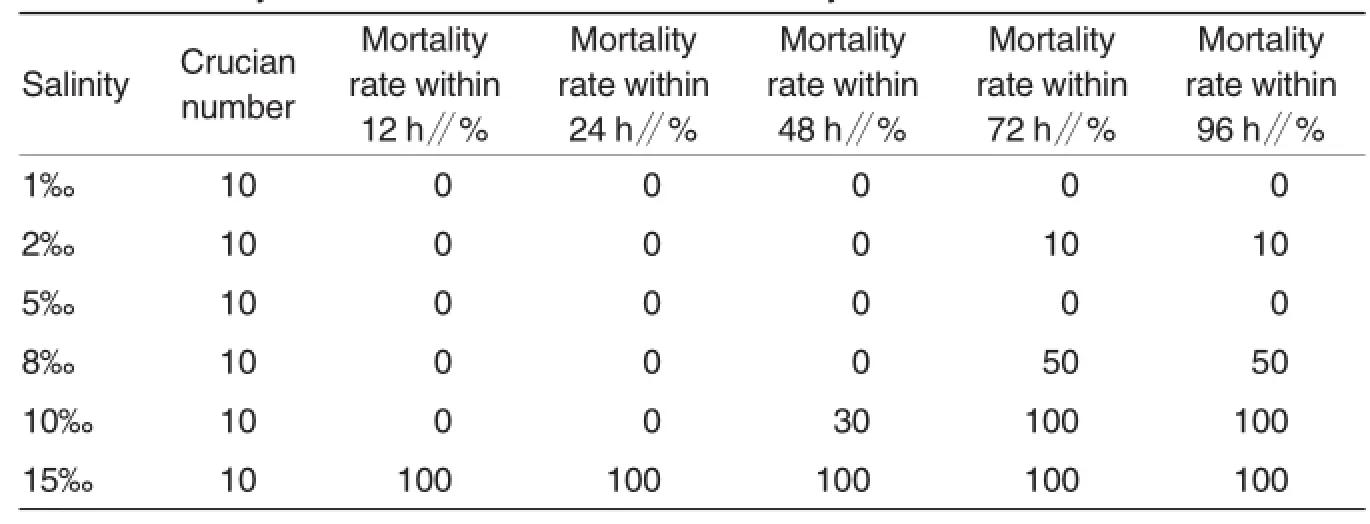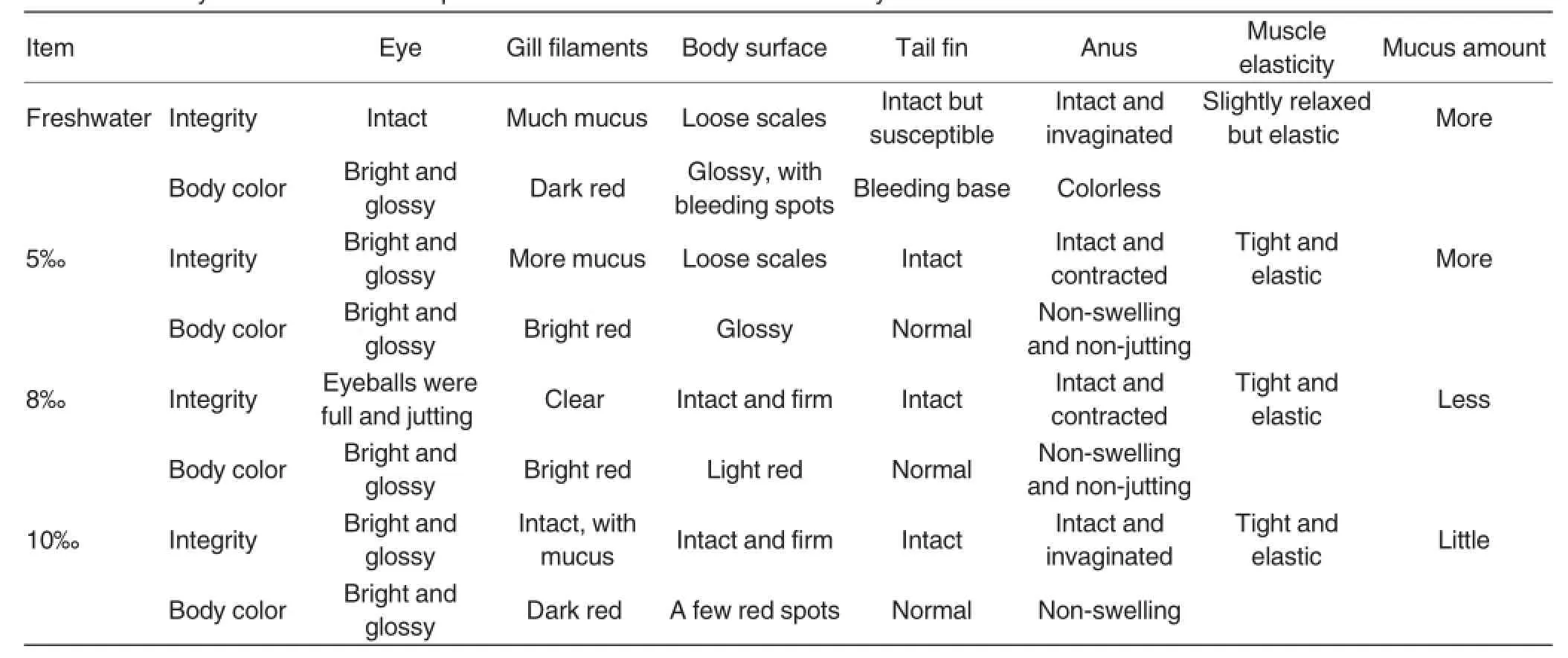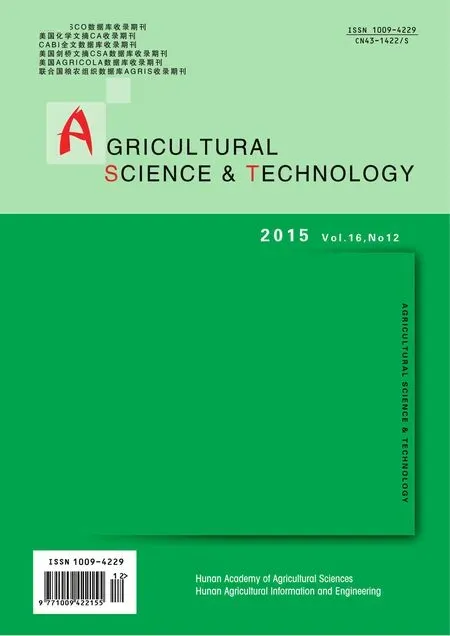Effects of Salinity and Freezing on Freshness of Crucian
2015-11-08GuishengGAOQiumeiSHlMuxiangGEJuanCHENYongmeiSUYulingDONGHongshengHANQingchunSONG
Guisheng GAO,Qiumei SHl*,Muxiang GE,Juan CHEN,Yongmei SU,Yuling DONG,Hongsheng HAN,Qingchun SONG
1.Hebei Provincial Key Laboratory of Preventive Veterinary Medicine/Hebei Normal University,Qinhuangdao 066600,China;
2.Qinhuangdao Liangfeng Marine Ecological Technology Development Co.,Ltd.,Qinhuangdao 066600,China;
3.Hebei Haohai Biotechnology Co.,Ltd.,Qinhuangdao 066004,China
Effects of Salinity and Freezing on Freshness of Crucian
Guisheng GAO1,Qiumei SHl1*,Muxiang GE1,Juan CHEN1,Yongmei SU1,Yuling DONG1,Hongsheng HAN2,Qingchun SONG3
1.Hebei Provincial Key Laboratory of Preventive Veterinary Medicine/Hebei Normal University,Qinhuangdao 066600,China;
2.Qinhuangdao Liangfeng Marine Ecological Technology Development Co.,Ltd.,Qinhuangdao 066600,China;
3.Hebei Haohai Biotechnology Co.,Ltd.,Qinhuangdao 066004,China
Salt tolerance and freeze preservation of crucian are always important concerns of people.There are rare reports on effect of different salinity on freshness and quality.However,water salinity will directly affect osmotic pressure in fish,thereby affecting meat quality.In this study,the tolerance of crucian to different salinities (1‰,2‰,5‰,8‰,10‰ and 15‰)was investigated.In addition,the effect of different salinity on freezing freshness and quality of crucian was studied. The results showed that the tolerance threshold of crucian to salinity was about 8‰,and the freezing quality of crucian in water with salinity of 8‰ was significantly better than that in fresh water.
Crucian;Salinity;Salt tolerance;Freshness
M ost freshwater fishes have certain salt tolerance.Water salinity is an important environment factor affecting fish quality,and itchangesbodycomponents through regulating osmotic pressure of fish,leading to changes in fish quality.Salt has certain hardness (2-2.5 grade),so it has certain massaging effect.Moreover,salt will not scratch the skin,and it will make the skin exquisite and smooth instead.Sodium chloride has functions of sterilizing,diminishing inflammation and relieving itching[1].Freeze preservation can maintain food freshness,nutritional value and original flavor to the greatest extent.Compared with that of refrigerated preservation,the storability of freeze preservation is 1.4 times higher[2].Foreign scholars have also conducted researches on refrigerated and freeze preservation of fishes[3]. With the steady and rapid development of freshwater fishery, fish preservation becomes more and more important to its quality.However,there are no systematic and in-depth researches on effect of freeze preservation on fish quality.Therefore,it is necessary to conduct scientific research on freeze preservation of freshwater fishes.
In this study,the tolerance of crucian to several salinities,as well as the effect of freeze preservation on crucian quality,was investigated.The growth status of crucian in differentsalinity waters,and its quality variation under the condition of freeze preservation,was explored,providing some reference for low-temperature storage and processing and quality control of freshwater fishes and development of relevant equipment.
Materials and Methods
Materials
The live crucians with average length of 20 cm and average weight of 250 g were purchased from an aquatic product market in Jieshi Mountain,Changli County,Qinhuangdao City,Hebei Province.The used instrumentsand equipment included pH meter,high pressure steam sterilizer,incubator,nutrient agar,etc.
Salt tolerance test
In the aquariums,different-salinity(1‰,2‰,5‰,8‰,10‰ and 15‰)waters were prepared.After the aeration,crucians were placed in the waters.There were two replicates for each salinity treatment.The swimming and performance of crucians were observed closely and recorded.Before the transplanting into salt waters,there were small bleeding spots,caused by little traumas,and little scale loss in the pectoral fins and pelvic fins,and tissue loss in caudal fins of crucians due to various seasons,such as salvage and collision.During the test,the performance of crucians,as well as the recovery conditions and recovery times of traumas,were observed.
Freeze preservation test
According to the results of salt tolerance test,three salinities(5‰,8‰and 10‰)with higher crucian survival rate were selected for the conduction of freeze(-20℃)preservation test.In addition,one freshwatertreatment was designed as the control.The sensory indexes,pH value,moisture content and bacterial colony number of crucian were measured[4].
Sensory measurementAfter the ice around the crucians melt naturally,the crucians were cleaned with distilled water.The back muscles of crucians were collected.Under the normal conditions,the smell and elasticity of crucian back muscle were observed with eyes[8].The sensory evaluation standards were shown in Table 1.

Table 1 Sensory evaluation standards
pH measurement A certain amount(2.0 g)of back muscle of each crucian was ground,and then dissolved in a certain volume(20 ml)of cooled boiling water.The mixtures were stood for 30 min and filtered.The collected filtrates were directly used for pH measurement[6].

Table 2 Mortality rate of crucians under different salinity
Results and Analysis
Results of salt tolerance test
When crucians were first placed into the waters with salinities of 10‰and 15‰,they were uneasy,swam back and forth,floated their heads,and even jumped.However,in the other waters,the crucians appeared normal.After 12 h,the bleeding spots in dorsal fins and anal fins of crucians in the low-salinity (1‰,2‰and 5‰)waters began to fester.After 24 h,the waters at various salinities all turned clear.The crucians in various aquariums swam normally,and their breathing and other functions were all normal by visual inspection.The crucian body injury in waters with salinities of 8‰and 10‰was lighter,and the bleeder area was also smaller.After 48 h,the crucians in the waters with salinities of 2‰and 5‰swam slowly,and their response to touching also became slow. Even worse,the bleeders in their heads,pectoral fins and pelvic fins were aggravated.In the water with salinity of 8‰,the lips swelling of crucians was reduced,and their bleeding spots were also reduced.In the water with salinity of 10‰ ,the crucians swam slowly,and their eyes were dimmed.After 72 h,in the water with salinity of 2‰,the crucian skin became pale and ulcerated,and more bleeding spots were shown in the mouths and tail fins of crucians.In the water with salinity of 8‰,the injury in crucian head was relatively light,but high-density bleeding spots appeared below crucian operculum.
Results of freeze preservation test Sensory measurement After the crucians were frozen,their bodies became harder,and the quality inspection also became more difficult.Therefore,during the inspection,only crucian eyeballs,skin color and hardness were inspected.Otherwise,the crucian body could be cut apart,thus the internal quality could be inspected. The sensory evaluation results of freeze-preserved crucians under different salinities were shown in Table 3. As shown in Table 3,the crucian’s eyes were intact in all the waters.With the increased salinity,crucian’s eyes became bright and glossy.In freshwater,crucian gill filaments had more mucus,and with the increased salinity,the mucus was still normal and bright red.In the freshwater,crucian muscle was relaxed to some extent.But with the increased salinity,crucian muscle became tight and elastic.There was little mucus on crucian body surface.Inthe freshwater,crucian tail fin was intact,and easy to be broken;the anus was not jutting.With the increased salinity,crucian anus contracted,but was not swelling or jutting.

Table 3 Sensory evaluation of freeze-preserved crucian under different salinity

Table 4 pH value of freeze-preserved crucian muscle under different salinity

Table 6 Total bacterial colony number in freeze-preserved crucian muscle under different salinity
pH measurement Raw meat quality will directly determine the quality of meat products,and pH value is one of the important indicators.If pH value is relatively low,meat will has longer shelf life and better flavor.As shown in Table 4,crucian muscle pH value changed greatly after the melt.The post-melt muscle pH value of crucian in the water with salinity of 10‰ was closest to the initially measured value(6.88),while the post-melt muscle pH value of crucian in the freshwater was lower than that of fresh crucian.
Moisture content determination
Moisture content will not only affect color,aroma,taste,nutritional components,juiciness,tenderness and edible quality,but also directly affect economic value of meat.As shown in Table 5,when water salinity was higher than 8‰ ,moisture contentin freeze-preserved crucian muscle was reduced,but the dry matter content in crucian muscle was trended to be increased with the increase of water salinity.
Measurement of bacterial colony number in frozen fish As shown in Table 6,before the freezing,the total bacterial colony numbers(diluted 100 times)in crucian muscle under different salinities were 40×104(freshwater),32×104(salinity of 5‰),27×104(salinity of 8‰)and 25×104(salinity of 10‰),respectively.After the freeze preservation,the total bacterial colony numbers in different-salinity waters were significantly reduced,and the total bacterial colony number in post-melt crucian muscle was reduced gradually with the increase of water salinity.
Conclusions
Crucian flesh has higher moisture content,so it is easy to be rotted.If the rotted crucian flesh is not handled in a timely manner,the proteins and amino acids inside the flesh will be decomposed under the action of microorganisms and a series of enzymes,seriously affecting the quality of crucian flesh.In order to ensure the quality of crucian flesh,refrigerated preservation or freeze preservation is an important way.Crucian has certain salt tolerance.The salinity in freshwater is generally lower than 0.5‰.In general,freshwater fish can live a normal life in the water with salinity lower than 5‰. The excessively high salinity in water will produce certain effects on growth and reproduction of freshwater fish.
Salt tolerance of crucian
Zang et al.[7]reported that different-specification fish ofthe same species has different-degree salt tolerance.There are chemical receptors in the mouth of fish.Thus,when water salinity is changed,the fish will feel it. Once water salinity is changed,the phenomenon of swallowing water will appear in fish.Ion concentration in fish body fluid directly affects environmental homeostasis in fish body.To ensure the balance of osmotic pressure,fish needs to consume the energy of the body.Therefore,salinity change,as a result of energy change,will also directly affect the growth of fish.From the results above,it can be concluded that freshwater crucian can adapt to a certain range of salinity,but not too high salinity.The water salinity cannot exceed 5‰.Otherwise,the growth status of crucian will be greatly aggra-vated,and death of crucian will even occur.However,the water with appropriate salinity will produce certain positive influence on physiological functions and meat quality of crucian.For example,the sensory quality of freezepreserved crucian in the water with salinity of 8‰ is better than those in the other waters.In freshwater,would in crucian is easy to be infected by pathogenic microorganisms.However,in the water with salinity of 8‰,the infection rate of crucian is smaller.However,the survival rate of crucian in high-salinity water is lower than that in freshwater.Therefore,crucian cannot be farmed in high-salinity water for a long time.Within the tolerance range,crucian can only dunked in high-salinity water for a short time for disinfection.The high-salinity water bath cannot be used as a recipe.Li et al.[8]found that the salt tolerance of fish can be improved after appropriate domestication.Although the crucians were not farmed in high-salinity water for a long time in this study,it could be expected that the salt tolerance of crucians would be improved.
Freezing effect under different salinity
The biochemical changes after the death have important influence on decreased freshness and quality change of freshwater fish.Although freeze preservation cannot stop biochemical changes,it can slow the changes.After the death of crucian,the glycogen in its organizations will be converted into lactic acid through anaerobic decomposition.At the same time,phosphocreatine is decomposed into inorganic phosphate and creatine. The exothermic reactions above produce a lot of heat,increasing body temperature of fish.If the fish is not refrigerated timely,the biochemical reactions will be sped up,affecting freshness of fish flesh.After the test in this study,crucian freshness differed greatly among different salinities of waters.Live crucian had blight color and firm and elastic body,and its cut surface was shiny.The freshness of freeze-preserved crucians in the salt waters was significantly better than that in the freshwater.In addition,in the water with salinity of 8‰,crucians had bright and lustrous eyeballs,firm scales and elastic and solid muscle,and their sensory quality was significantly higher than that of crucians in the other waters.In conclusion,crucians should be better preserved in water with salinity of 8‰ before their freeze preservation.
Effects of freeze preservation on pH value and moisture content of crucian
Previous studies have shown that pH value of samples is reduced first and then decreased under the conditions of refrigeration and freezing.In the early stage,liver glycogen is degraded into creatin under anaerobic condition,leading to decreased pH value of muscle.At the same time,the energy released by ATP decomposition in muscle increases body temperature,leading to protein acidic coagulation and muscle rigidity.However,muscle turns soft gradually due to ATP decomposition.Proteins are decomposed into a series of intermediate products,amino acids and soluble nitrogen-containing substances,as well as alkaline substances,increasing muscle pH value[9].Raw meat quality directly determines the quality of meat products,and the pH is one of the important indicators.If pH value is relatively low,meat will has longer shelf life and better flavor[10].If pH value is relatively high,meat will has better color.The quality of normal meat is within the two standards above.If the measured pH value shows great difference with the normal level,the meat quality is generally considered to be poor.However,if the measured pH value is close to the normal level,the meat is considered to be qualified and to have good hygienic quality.In this study,the crucian muscle pH value changed after the melt,and the postmelt muscle pH value of crucian in the water with salinity of 10‰was closest to the initially measured pH value(6.88).It suggests that certain salinity has more positive influence on freshness of freeze-preserved crucian. Moisture content in muscle not only affects the flesh color,aroma,taste,nutrition,juiciness,tenderness and edible quality,but also directly affects the economic value.When the water salinity was higher than 8‰,the moisture content in freeze-preserved crucian muscle was reduced with the increase of salinity,but the dry matter content in crucian was trended to be increased. This phenomenon shows that when the fish is placed in hypertonic water,it will be dehydrated,and under the severe condition,the fish will die.The total bacterial colony number in postmeltcrucianmusclewasreduced gradually with the increase of salinity,which was because that sodium chloride has inhibitory effect on several common bacteria.
Discussion
Crucian can adapt the salinity lower than 8‰.The quality of freeze-preserved crucian in the water with salinity of 8‰ is significantly higher than that in freshwater.
[1]CHEN G(陈刚),YU ZJ(郁正娟).Development of series hygienical salt(系列健美盐的研究开发)[J].Sea-lake Salt and Chemical Industry(海湖盐与化工),2003,32(1):30-31.
[2]LIU ZM(刘志鸣),WAN JQ(万金庆),WANG JM (王建民),et al.History of Japanese controlled freezing point technique(日本冰温技术发展史略)[J].Refrigeration&Air-Conditioning(制冷与空调),2005,20(3):70-74.
[3]GRAM L,OUNDO J,BON J.Storage life of Nile perch(Lates niloticus)dependent on storage temperature and initial bacterial load[J].Trop Sci,1989,29: 221-236.
[4]LI H(李辉),LIU LF(刘莲风).Studies on the texture and rheological properties of Paralichthy olivaceus under controlled freezing point storage(冰温保鲜条件下牙鲆的鲜度及质构变化)[J].Progress in Fishery Sciences(渔业科学进展),2011,32(3):65.
[5]NAN QX(南庆贤).Meat industry manual(肉类工业手册)[M].Beijing:China Light Industry Press(北京:中国轻工业出版社),2003.
[6]WANG KY (王开阳).Identification method of freshness quality of aquatic product(水产品鲜度的质量鉴别方法)[J]. Journal of Beijing Fisheries(北京水产),2002,1:41.
[7]ZANG WL(藏维玲),WANG W(王武),YE L(叶林),et al.Toxic effects of salinity(S‰)on some freshwater fishes(盐度对淡水鱼类的毒性效应)[J].Oceanologia et Limnologia Sinica(海洋与湖沼),1989,20(5):445-451.
[8]LI JL(李家乐),LI SF(李思发).Study on salinity tolerance of GIFT strain of Nile Tilapia(吉富品系尼罗罗非鱼耐盐性研究)[J].Journal of Zhejiang Ocean University(Natural Sciences)(浙江海洋学院学报 (自然科学版)),1999,18(2):107-110.
[9]LI HL(李华丽),HE YB(何煜波).Study on salinity tolerance of GIFT strain of Nile Tilapia(吉富品系尼罗罗非鱼耐盐性研究)[J].Meat Industry(肉类工业),2005(2):24-29.
[10]LIANG Q(梁琼),WAN JQ(万金庆),WANG GQ(王国强),et al.Changes in quality properties of herring fillets during ice storage(青鱼片冰温贮藏研究)[J].Food Science(食品科学),2010,6: 271-272.
Responsible editor:Tingting XU
Responsible proofreader:Xiaoyan WU
盐度及冰冻对鲫鱼保鲜效果的影响
高桂生1,史秋梅1*,葛慕湘1,陈娟1,苏咏梅1,董玉玲1,韩红升2,宋青春3(1.河北科技师范学院/河北省预防兽医学重点实验室,河北秦皇岛066600;2.秦皇岛粮丰海洋生态科技股份有限公司,河北秦皇岛066600;3.河北皓海生物科技有限公司,河北秦皇岛066004)
淡水鲫鱼的耐盐性及冰冻保鲜一直是人们关注的一个重要问题。而不同盐度对保鲜品质的影响很少报道。但水体盐度直接影响鱼体渗透压进而影响肉质品质。该试验研究了鲫鱼对盐度1‰、2‰、5‰、8‰、10‰、15‰的耐盐性,以及不同盐度的冷冻保鲜效果。研究结果表明,鲫鱼的耐盐性为8‰以下,在8‰的水体中进行冷冻保存效果明显高于淡水保存的鲫鱼。
鲫鱼;盐度;耐盐性;保鲜
河北省科技厅奖励性后补助项目(15926620H);秦皇岛市科技局科技支撑计划(201401A067,201402B043)。
高桂生(1964-),男,河北玉田人,副教授,硕士,从事水产养殖动物疾病防治方面的研究,E-mail:Ggs1964@163.com。*通讯作者,教授,博士,从事动物传染病防治方面的研究,E-mail:shiqiumei@126.com。
2015-09-08
Supported by Incentive Program Subsidized by Department of Science and Technology of Hebei Province(15926620H);Key Technology Research and Development Program of Science and Technology Bureau of Qinhuangdao City(201401A067,201402B043).
*Corresponding author.E-mail:shiqiumei@126.com
Received:September 8,2015 Accepted:November 21,2015
修回日期 2015-11-21
猜你喜欢
杂志排行
Agricultural Science & Technology的其它文章
- Study on Engineering Characteristics and Application of Sticky Rice
- Periodical Development Trend of Vertical Greening
- Advances in Microbial Remediation on the Application of Heavy Metal Pollution in Agricultural Water Resources
- Analysis on Status quo and Future Development of Fruit and Vegetable Protreatment
- Effect of Three Treatment Measures on Harmless Seedling Raising of Pinus sylvestris var. mongolica Litv.
- Discussions and Recommendations for Supervision of Vegetable Quality and Safety in Miyun County
